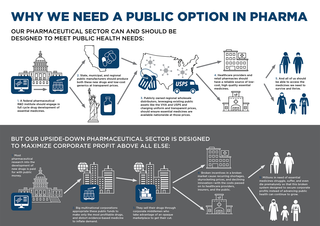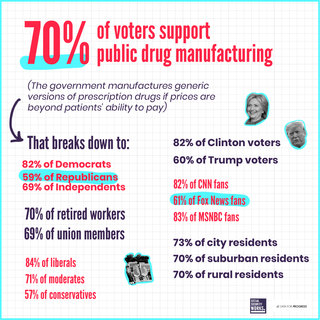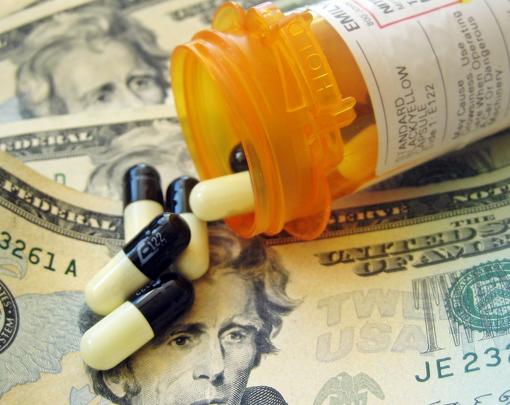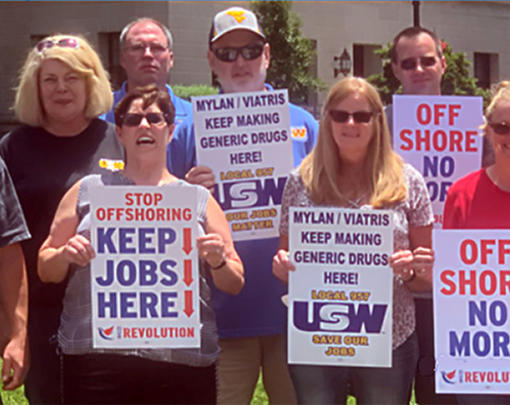Executive summary
Too many Americans are suffering and dying prematurely because we have ceded control over a key part of our infrastructure for public health—the pharmaceutical industry—to unaccountable corporations, for whom the pursuit of profit trumps the needs of patients and communities. Instead of continuing to push the boulder of regulation up the hill in hopes that it one day finally proves effective, we can displace corporate power over our health and lives by moving towards a democratic, publicly-owned pharmaceutical sector, designed to respond to public health needs and deliver better health outcomes at lower costs.
Democratic, public ownership of pharmaceutical development, production, and distribution in the U.S. is necessary to combat the increasingly harmful impacts of Big Pharma which decades of regulation have failed to counteract. These impacts are:
- Catastrophic for public health: Dangerous, and sometimes deadly, medication-rationing is on the rise due to skyrocketing prices. Big Pharma also has a well-documented history of dangerous and illegal misbranding and promotion of medications and distortions of evidence-based medicine, leading to tragedies like the opioid epidemic which has claimed over 400,000 lives so far. Profit-motivated business decisions have also created increasing rates of post- market safety issues and critical shortages1 with decreasing rates of innovation.2
- Economically regressive: Much of the profit extracted by pharma companies represents a form of double-taxation, as public funding underpins pharmaceutical R&D, but the public pays again through out-of-pocket prescription costs, contributions to Medicare and Medicaid and rising insurance premiums. We also lose massive amounts of public revenue (which could be used for healthcare and public services) through the tax evasion rampant in the sector. The highly financialized nature of the industry also makes it a contributor to growing economic inequality. The highest drug prices in the world, coupled with differential pricing further impact our most at-risk patients and communities. Concentration in the market produces anti-competitive behavior which contributes to rising costs and lack of availability of new medications.
- Dangerous for democracy: With the largest lobby in the US, and a well-oiled revolving door, Big Pharma exemplifies regulatory capture. The money it pours into political donations contributes to corporate influence over government that has left us with an industry essentially immune to regulation. Massive waves of mergers and acquisitions which obscure the flow of money through the pharmaceutical supply chain and the industry’s rejection of all attempts to increase transparency has left consumers and lawmakers without the information they need to effectively hold the industry to account through the democratic process.
Developing a public pharmaceutical sector presents a systemic approach to these issues, superseding the need for piecemeal reform which could be rolled back in the future. We see this new public pharmaceutical sector as a resilient ecosystem, with publicly-owned companies across the supply chain set up at local, state, regional and national levels. Moreover, public pharmaceuticals would produce improved outcomes for our health, economy and democracy even in the absence of other interventions such as patent reform, anti-trust action, or changes to our health insurance system.
Public control of pharmaceutical manufacturing, wholesale distribution and retail pharmacies could serve as the basis for large-scale upstream investments in public health3 through the development of associated educational opportunities and job pipelines—part of an inclusive industrial strategy for economic development and stabilization, with profit now captured by corporations reinvested to meet public needs. Existing public resources like the Veterans Health Administration and the US Postal Service could be leveraged to help deliver medications, and public, unitary pricing on medications and their distribution would create transparency in the pharmaceutical supply chain that could inform further policy efforts.
Public ownership in pharmaceutical R&D would ensure that more intellectual property related to drug development would be held by public institutions and utilized in the public interest. Right now, a small number of newer medications are responsible for the majority of pharmaceutical spending by public programs like Medicare and Medicaid. Ensuring that new drug development is done in the public interest assures that not only do we get the medications that we need for the most pressing public health concerns (rather than the most profitable health issues), but also that those medications come at an accessible price.
Public production of generic medications alone could have great benefits for public health, as well as economic benefits for patients and insurers alike. Currently there are around 180 off-patent drugs with no generic equivalent on the market.4 There are a further 500+ drugs with only one generic on market5 , and as the FDA has found, when there’s only one generic, it is usually priced just below the brand name drug. It is not until the second generic is introduced that prices drop precipitously.6
Coupled with the issue of recurring shortages, a clear role for public pharmaceuticals would be to assure the adequate supply of generics, especially for essential medicines—many of which are currently in short supply in the United States. However, we maintain that truly ensuring the affordable medicine a healthy America needs requires looking beyond generics to a fully public pharmaceutical sector running from the R&D lab all the way to the end user in the hospital room or pharmacy.
Pharmaceutical spending is now the fastest growing portion of a healthcare sector that is already approaching a fifth of the US economy—while life expectancy declines. No reform currently under serious consideration would challenge the underlying profit-driven structure of the industry which allows it to function outside democratic, public control and contrary to vital public needs.
Publicly-owned pharmaceuticals, free of the structural need to appease profit-hungry shareholders, would be able to focus first and foremost on public health priorities, working hand in hand with public health departments (as they do in other countries) to assure an adequate supply of medications priced to be accessible to the broadest array of Americans. Countries including Sweden, Brazil, Cuba, and China have successful public pharmaceutical industries from which we can learn. Furthermore, Americans from across the political spectrum already support the idea of public production of essential medications.7
With mounting public pressure to take action against Big Pharma and control drug prices, now is the time for bold long-term solutions that can help secure the future health and wellbeing of our communities. Public pharmaceuticals can play an important role in constructing that future we so desperately need.
Read the full report
Request printed copies
We are excited to make printed copies of this report available at no cost for organizations and individuals working for health justice. Let us know how the report can be help you in your work here.
Legal analysis: Creating a California Public Pharmaceutical Manufacturing Corporation
One of our key recommendations in the report is the possibility of using publicly-owned entities at the state and local level as components of a comprehensive public option for the pharmaceutical sector. Importantly, by starting in the “laboratories of democracy,” a progressive city or state could bypass federal gridlock and begin to directly address skyrocketing costs and critical shortages. To help demonstrate the feasibility of this approach, and to flesh out the details of a possible implementation strategy for our recommendation, we worked with the Sustainable Economies Law Center to prepare a legal memo explaining how this would work in the California context.
Download and read the memo now
Infographic: Why we need a public option in pharma
Video: The case for public pharma
In this short video, report author Dana Brown provides a basic overview of why we need a public option in the pharmaceutical industry:
Public Support
A September 2019 YouGov poll conducted for Data for Progress and Social Security Works found majority support among registered voters for a number of policy changes referenced in our Medicine for All report. In particular, about 70% of voters would support governments stepping in to produce generic drugs when prices are too high, and an even higher percentage would support allowing companies to produce generic competition.
Also winning majority support are policies that would require full public disclosure of all pharmaceutical research and development costs, prohibitions on direct-to-consumer and direct-to-provider advertising of prescription drugs, a $40 billion increase in government funding of research to develop drugs that would be immediately available at an affordable price upon approval, and monetary prizes to researchers for drug innovations with a requirement that the patents for those drugs be in the public domain.
In the News
Stat: Insulin: a case study for why we need a public option in the pharmaceutical industry
In the past few years we’ve learned about the tragic and preventable deaths of 20-somethings who simply couldn’t afford their insulin, even with insurance, and many people who depend on insulin to survive are sacrificing their rent, their cars, and their dignity just to get by. If we act now to institute a public option for pharmaceuticals, we could ensure that this terrible story is never repeated. Continue »
The New Republic: The Case for a Public Option for the Drug Industry
The proposed bankruptcy settlement by opioid maker Purdue Pharma raises an important question: If plaintiffs are open to the idea of turning Purdue into a public trust run by appointees of a federal bankruptcy judge, why not take one more step? Why not create the beginnings of a network of public pharmaceutical companies like those that already exist in such countries as Sweden, Brazil, and Thailand? Continue »
Common Dreams: Removing the Profit From Our Pills: The Case for a Public Pharma System
For generations, we have been protected by policing and firefighting services that are public, not for-profit corporations that turn away residents in danger when they cannot fork over cash-on-demand. We make sure our primary and secondary schools, our critical infrastructure, and our court and election systems are accessible to all, without the price barriers that for-profit corporations naturally create. We should do the same with essential medicines. Continue »
Common Dreams: Pelosi Plan Not Enough: Lower Drug Prices Now Through a Pharmaceutical Public Option
There are some key perspectives that Congress should take into account. The most important is that any solution to the drug pricing crisis should include a public option for pharmaceuticals. Markets aren’t designed to prioritize the public good over corporate greed; that is why we need a public alternative that is solely dedicated to the public’s health priorities. Continue »
- 1“Drug Shortages, Pricing, and Regulatory Activity”, in Measuring and Modeling Healthcare Costs, Ana Aizcorbe, Colin Baker, Ernst Berndt, and David Cutler, eds, the National Bureau of Economic Research, 2018, http://www.nber.org/chapters/c13102. pdf.
- 2Adam Gaffney and Joel Lexchin, “Healing an ailing pharmaceutical system: prescription for reform for United States and Canada,” British Journal of Medicine, May 2018, doi: 10.1136/bmj.k1039.
- 3An upstream investment in health is an investment directly in one of the “social determinants of health” such as jobs, affordable housing, education, or environmental health and safety.
- 4US House of Representatives, Energy and Commerce Committee, “Examining FDA’s Generic Drug and Biosimilar User Fee Programs Hearing,” Question to Dr. Janet Woodcock, March 2017, https://energycommerce. house.gov/hearings-and-votes/hearings/examining-fdas-generic-drug-and-biosimilar-user-fee-programs.
- 5Henry Waxman, Bill Corr, Kristi Marin and Sophia Duong, “Getting to the Root of High Prescription Drug Prices,” The Commonwealth Fund, July 2017, http://www.commonwealthfund.org/~/media/files/publications/fund-report/2017/jul/waxman_high_drug_prices_drivers_solutions_report.pdf.
- 6“Generic Competition and Drug Prices,” FDA: https://www.fda.gov/AboutFDA/CentersOffices/OfficeofMedicalProductsandTobacco/CDER/ucm129385.htm.
- 7Alex Lawson and Stephanie Taylor, “We Need a Public Option for Prescription Drugs,”The American Prospect, http://prospect.org/article/we-need-public-option-prescription-drugs.






